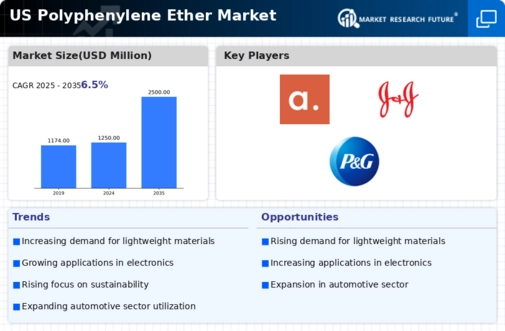The polyphenylene ether (PPE) market is currently characterized by a competitive landscape that is both dynamic and multifaceted. Key growth drivers include the increasing demand for high-performance materials across various industries, such as automotive, electronics, and consumer goods. Major players like BASF SE (Germany), Mitsubishi Engineering-Plastics Corporation (Japan), and SABIC (Saudi Arabia) are strategically positioned to leverage innovation and technological advancements. For instance, BASF SE (Germany) focuses on enhancing its product portfolio through sustainable practices, while SABIC (Saudi Arabia) emphasizes regional expansion and partnerships to strengthen its market presence. Collectively, these strategies contribute to a competitive environment that is increasingly shaped by innovation and sustainability initiatives.
In terms of business tactics, companies are increasingly localizing manufacturing and optimizing supply chains to enhance efficiency and responsiveness to market demands. The competitive structure of the PPE market appears moderately fragmented, with several key players exerting influence over market dynamics. This fragmentation allows for a diverse range of products and innovations, although it also necessitates that companies differentiate themselves through unique value propositions and operational excellence.
In October 2025, Mitsubishi Engineering-Plastics Corporation (Japan) announced a significant investment in expanding its production capacity for PPE materials in North America. This strategic move is likely to enhance the company's ability to meet growing demand in the region, particularly in the automotive sector, where lightweight and durable materials are increasingly sought after. Such an expansion not only positions Mitsubishi as a key player in the North American market but also underscores the importance of regional manufacturing capabilities in meeting local customer needs.
In September 2025, SABIC (Saudi Arabia) launched a new line of PPE products designed specifically for the electronics industry, focusing on improved thermal stability and electrical insulation properties. This product innovation is indicative of SABIC's commitment to addressing the evolving requirements of high-tech applications, thereby reinforcing its competitive edge. By aligning product development with industry trends, SABIC is likely to capture a larger share of the electronics market, which is experiencing rapid growth.
In November 2025, Kraton Corporation (US) entered into a strategic partnership with a leading automotive manufacturer to develop advanced PPE composites aimed at enhancing vehicle performance and sustainability. This collaboration is expected to yield innovative solutions that not only meet regulatory standards but also appeal to environmentally conscious consumers. Such partnerships reflect a broader trend in the industry where collaboration is becoming essential for driving innovation and addressing complex market challenges.
As of November 2025, current competitive trends in the PPE market are increasingly defined by digitalization, sustainability, and the integration of artificial intelligence (AI) in production processes. Strategic alliances are playing a pivotal role in shaping the landscape, enabling companies to pool resources and expertise to foster innovation. Looking ahead, it is anticipated that competitive differentiation will evolve from traditional price-based competition to a focus on innovation, technology, and supply chain reliability. This shift underscores the necessity for companies to adapt and innovate continuously to maintain a competitive advantage in a rapidly changing market.














Leave a Comment